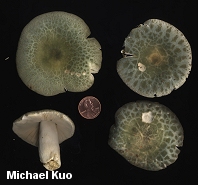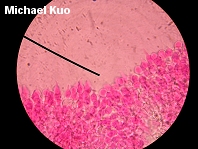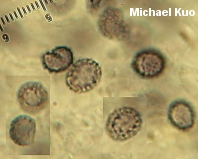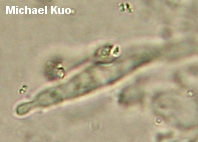| Major Groups > Gilled Mushrooms > Pale-Spored > Russula > Russula parvovirescens |

|
Russula parvovirescens [ Basidiomycetes > Russulales > Russulaceae > Russula . . . ] by Michael Kuo Russula parvovirescens is a gorgeous and distinctive russula, recently separated from the well-known traditional species Russula virescens. It is an eastern North American species that differs from the classic concept of Russula virescens in its blue-green colors, larger crustose patches, lined cap margin, generally smaller stature, and in its pileipellis (details below). Illustrations of "Russula virescens" in several North American field guides (published or placed in press before Russula parvovirescens was named in 2006) appear to represent Russula parvovirescens, including Metzler & Metzler (1992), Roody (2003), Miller & Miller (2006) and Kuo (2007). Description: Ecology: Mycorrhizal with oaks and other hardwoods--and apparently with conifers; growing alone, scattered, or gregariously; summer and fall; apparently widely distributed from Texas to Maine. Cap: 4-8 cm; round to convex when young, becoming broadly convex to flat, with a shallow depression; dry; velvety; the surface soon cracking up to form large crustose patches up to 8 mm across; green to blue-green; the margin lined; the skin peeling about one-third of the way to the center. Gills: Attached to the stem or nearly free from it at maturity; forking occasionally; close; creamy. Stem: 3-6 cm long; up to 2 cm thick; dry; smooth; white; discoloring a little brownish with age or on handling. Flesh: White; brittle; thick; not changing when sliced. Odor and Taste: Odor not distinctive; taste mild. Chemical Reactions: KOH on cap surface negative. Iron salts on stem surface negative. Spore Print: Creamy. Microscopic Features: Spores 7-9 x 6-7 µ; elliptical to subglobose; warts extending to about 0.5 µ high; connectors scattered, occasionally forming partially reticulated areas. Pleurocystidia scattered to abundant. Pileipellis a cutis overlaid with an epithelium composed of elements of chained cells which diminish only slightly in width from base to tip, with the terminal cell sometimes projecting a short extension but not generally tapering and elongated (compare to Russula virescens); pileocystidia long and slender, arising in the cutis, cylindric with subcapitate or subacute apices, positive in sulphovanillin. REFERENCES: Buyck, Mitchell & Parrent, 2006. (Buyck, 2007.) Herb. Kuo 06270808. This site contains no information about the edibility or toxicity of mushrooms. |
© MushroomExpert.Com |
|
Cite this page as: Kuo, M. (2009, March). Russula parvovirescens. Retrieved from the MushroomExpert.Com Web site: http://www.mushroomexpert.com/russula_parvovirescens.html |



